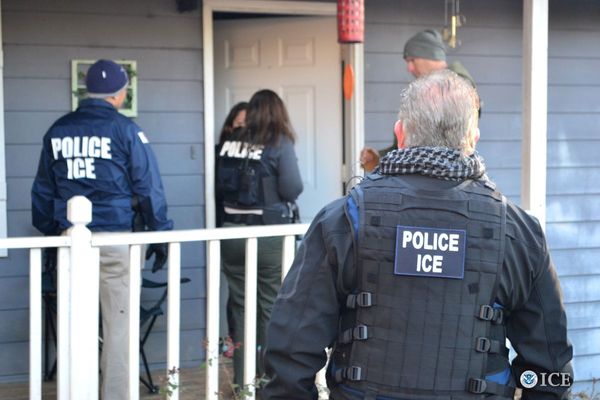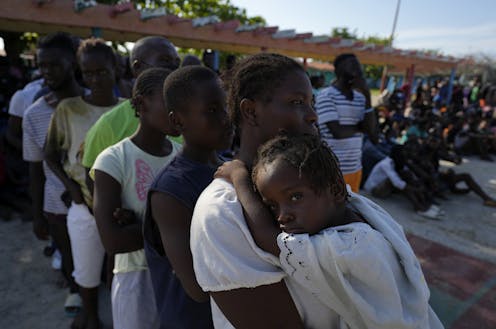
The first protected category of the United Nations refugee convention is race. The 1951 convention defines a refugee as a person who is outside their country of residence or nationality “owing to well-founded fear of being persecuted for reasons of race, religion, nationality, membership of a particular social group or political opinion.”
Racism negatively affects the lives of Haitians at home and abroad. Yet Haitian migrants today are rarely deemed eligible for asylum.
This requires us to think about racism and the treatment of refugees transnationally. Brazil-led UN peacekeeping operations and the outsourcing of U.S. immigration control to Latin America further complicates asylum for Haitians.
Why is race is so central to the UN’s refugee convention? Probably because much of it was drafted by former Jewish refugees from the Holocaust and their allies. The drafters added two important clauses.
The first one, Article 3, stipulates non-discrimination by the receiving countries (by “race, religion, and country of origin”). The second is the principle of non-refoulement that prohibits countries from returning migrants to dangerous conditions back home.
Other considerations that determined the final scope of the convention include the breakup of empires and wealthy countries’ continued racial barriers to immigration.
Haiti, colonialism and empires
Much of the racism toward Haitians comes from abroad.
In the late 1700s, Haitian revolutionaries expelled French colonizers and abolished slavery. A few years later, Haiti provided refuge for victims of enslavement and colonialism elsewhere.
But France and other countries demanded reparations for their lost “property,” meaning human beings. Haiti had to pay this debt throughout the 20th century.
From 1915 to 1934, the United States military occupied Haiti, with lasting social and political consequences. In 1937, Dominican dictator Rafael Trujillo ordered the slaughter of thousands of Haitians living near the border.
From the 1950s through the 1980s, the U.S. supported the Duvalier dictatorship. Since then, there has been nearly continuous foreign intervention in Haiti’s politics.
Facing economic and political instability, many Haitians go abroad to improve life for themselves and their relatives back home. For Haitians, the lines between diaspora, economic migrant and refugee are often blurred. But legally, these categories can make all the difference.
U.S. sent Haitians back home
Starting in 1981, the U.S. adopted a policy of interdicting and processing Haitian migrants at sea. This effectively established a loophole and allowed them to circumvent the principle of non-refoulement and send Haitians back home.
Following this precedent, wealthy countries today increasingly started to put immigration on “remote control” — in other words, they control immigration from a distance, in international waters and third countries’ territories.
There is now a broader outsourcing of security and human rights as Latin American countries have been put in charge of receiving refugees and managing UN peacekeeping missions.
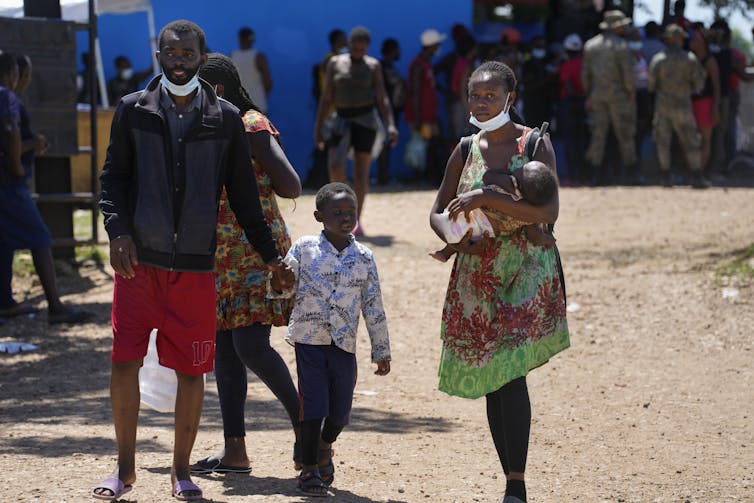
Brazilians in Haiti, Haitians in Brazil
In 2004, democratically elected Haitian President Jean Bertrand Aristide was ousted for the second time, probably with the help of the U.S. Canada, France, the U.S. and other major players quickly recognized the regime that replaced him. Later that year, Haiti received a peacekeeping mission, the United Nations Stabilization Mission in Haiti, known as MINUSTAH.
Until 2017, MINUSTAH’s multinational military force was run by Brazilian generals, with much meddling from the U.S., Canada and France.
In order to depoliticize the situation, these generals were instructed to deal with the problem of “gangs” by force. Urban neighbourhoods, where gangs supposedly resided, were precisely the bases of Aristide’s political support.
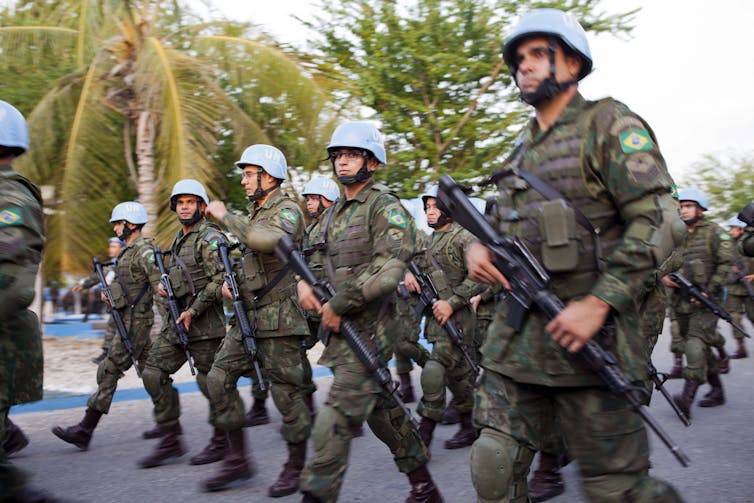
In a book about the military commanders of MINUSTAH, these generals called the low-income neighbourhoods of Port-au-Prince “favelas,” or shantytowns, suggesting the problem was one of policing.
Another term they use is pacificação. This is not just a translation of peacekeeping. Historically, pacificação was an euphemism for the colonization of Indigenous Peoples.
It’s also a reference to the work of Rio de Janeiro’s police units called Unidades da Policia Pacificadora. There was an ongoing exchange of security management personnel, ideas and practices between Port-au-Prince and Rio de Janeiro during that period.
After the massive 2010 earthquake that displaced hundreds of thousands of survivors, Brazilian authorities became concerned about Haitians arriving in their country.
My ongoing research with professors Martha Balaguera and Luis van Isschot at the University of Toronto explores how Haitian migrants are treated in Brazil, Colombia and Mexico.
‘Special relationship’
Brazilian immigration policy is determined by the Conselho Nacional de Imigração (CNIg). In CNIg’s meeting minutes, government officials mention Brazil’s “special relationship” with Haiti (the MINUSTAH operation) as a reason to accept Haitian migrants.
However, they argue that Haitians are not refugees, since they migrated because of the earthquake. They don’t acknowledge Brazil’s contribution to Haiti’s political and economic instability.
Brazilian officials express concern that Haitians will “establish a more permanent Haitian diaspora” in Brazil. This discourse is consistent with Brazil’s longer history of racially biased immigration policy that favoured Europeans.
In response, Brazilian officials created a humanitarian visa specifically for Haitian migrants. It provides temporary legal status, but doesn’t come with the same protections from deportation and government resources as asylum.
As the Brazilian economy worsened, many Haitians went north, hoping to get to the U.S. or Canada. Many go through Colombia, via the Darien Gap, a dangerous zone that links Colombia to Central America.
Haitians travel north
In Colombia, Haitians join other migrants’ routes. This includes Colombians, many of African and Indigenous descent, who were displaced through land-grabbing by paramilitaries and local elites. Others are from Venezuela, Africa and Asia.
Further north, they join Central American migrants escaping violence from the transnational war on drugs.
Read more: Trump and Biden ignore how the war on drugs fuels violence in Latin America
Then they go to Mexico, where the U.S. has outsourced the management of asylum-seekers.
Many give up and stay in Tijuana.
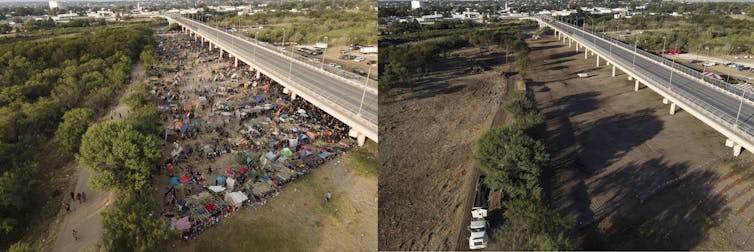
In southern Mexico, a kind of open-air prison was created to contain refugees without the right papers to go north. Those who reach the U.S. are then detained, after which many get deported.
The 1951 refugee convention was designed to protect people fleeing conditions created by Nazi Germany’s genocidal anti-Jewish racism. But the refugee system fails to prevent the pervasive and often deadly forms of racism that Haitians face. This racism is transnational, and its source are the countries of destination.
Luisa Farah Schwartzman does not work for, consult, own shares in or receive funding from any company or organisation that would benefit from this article, and has disclosed no relevant affiliations beyond their academic appointment.
This article was originally published on The Conversation. Read the original article.




